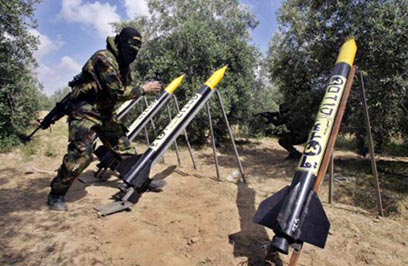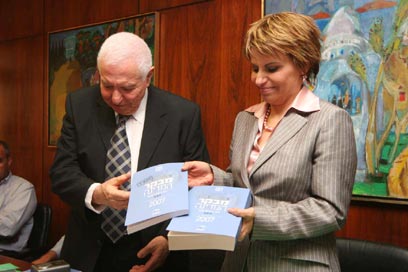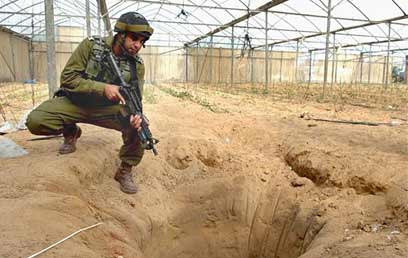
Comptroller's report reveals failure in dealing with Qassam threat
State comptroller submits annual report, focuses on IDF's flaws in handling rocket threat from Gaza Strip. He also states that almost nothing was done to prevent terrorists in Gaza from using underground tunnels
Failures in Israel's ability to deal with the Qassam threat from the Gaza Strip were uncovered in State Comptroller Micha Lindenstrauss' annual report submitted to Knesset Speaker Dalia Itzik and chairman of the Knesset's House Committee MK Zevulun Orlev on Wednesday.
In the main chapter of the 1,118-page report, Lindenstrauss addressed the defense establishment and detailed its failures in evaluating and dealing with the threat to Israel's southern communities.
The comptroller stated that the IDF had not consolidated a complete work plan to deal with the Qassam threat in full, despite that fact that by the end of 2006, 1,914 Qassams had been fired into Israel.
According to the report, the Israel Defense Force did not have operational ability to intercept ground-to-ground rockets, including Qassams, until December 2005, neither did it express demand for a short-range rocket interception system. The report also showed flaws in the IDF staff's performance.

Launching rockets toward Sderot (photo: AFP)
The report said that the IDF did not examine all the aspects in which the rocket threat could be dealt with, for example, preventing shooting by dealing with the enemy's infrastructure, which would depend on prior intelligence. The staff only focused on the ability to locate and attack rocket launchers.
The IDF spokesperson's office said in response that "since 2001 the IDF has been working to promote the development of retaliation to the high-trajectory weapon shootings. Dealing with high-trajectory weapons means combining advanced technological abilities with existing operational abilities, meant to minimize high-trajectory weapon blows.
"The IDF accepts the comptroller's comments on the urgent need to consolidate an effective multi-year work plan to give a comprehensive response to the high-trajectory weapon shootings. The staff is currently focusing on this matter, and dealing with handling short-range high-trajectory weapons shootings and defining fields of responsibility. The staff's work will be complete by the end of the 2007 work year."
Failure in dealing with Gaza tunnels
Lindenstrauss also stated that almost nothing was done to prevent terrorists in Gaza from using underground tunnels. According to the comptroller, the use of tunnels has increased significantly in recent years and become a major strategic threat.
His report stated that, from 2001 to 2004, terror organizations in southern Gaza succeeded in carrying out five terror attacks by utilizing these tunnels, resulting in the death of seven IDF soldiers.
Palestinians have continued using the tunnels for terror purposes despite the 2005 disengagement from Gaza.
Lindenstrauss also noted that such underground tunnels were used widely by Hizbullah operatives in southern Lebanon, as was witnessed in the Second Lebanon War. He added that underground warfare constitutes a potential threat on additional fronts, including the seam zone in the West Bank.
In December 2004, a unit was created to address the threat, within the IDF's Gaza Division, under the jurisdiction of Southern Command.
In February 2005, the IDF's Chief of Staff authorized cooperation between this unit and the IDF's air force rescue unit. Although the idea was based on recommendations following a tunnel-based attack that resulted in fatalities, such cooperation was never implemented.
An additional problem for defense constituted by the tunnels is the ongoing smuggling of weapons and explosives, to Gaza from Egypt, following the disengagement.
Lindenstrauss found that this issue was not examined adequately, despite intelligence reports that terror organizations were attempting to use the tunnels to smuggle weapons and carry out attacks.

Lindenstrauss presents report to Knesset Speaker Itzik (Photo: Gil Yohanan)
The comptroller wrote that security forces missed an important opportunity to examine the underground threat up close and to advance efforts in combating it.
He also found that there were conflicting approaches among the defense establishment regarding the distribution of intelligence information regarding underground threats. In Lindenstrauss' opinion, due to the fact that resolution of such threats involves several military branches, the issue should be reexamined in depth. He suggested that, if a consistent policy could not be found, the issue should be decided by the political leadership.
The IDF responded that "in recent years, with the increased use of underground warfare by Palestinian terror organizations, the IDF has made many efforts – using technology, battle troops and intelligence forces – to uncover and destroy underground tunnels.
"The threat of tunnels, with its unique characteristics as seen in Gaza, is part of a new kind of warfare, previously unseen in Israel, and without known technological solutions in Israel or the rest of the world.
"As such, we did not have the tools or the combat experience necessary to deal with this issue immediately, but most of the comptroller's recommendations had already been adopted in the period before his investigation."
The comptroller also criticized the decision to build an airport near Timna – north of Eilat – without prior coordination with Jordan. He stated that Knesset members made a decision authorizing the airport without receiving a full picture of the security limitations in the area.
Lindenstrauss wrote that, in his opinion, the interior minister should delay building permits for an airport so close to the border.
Disengagement cost doubled
Failures were also found in the estimation of the cost of the disengagement plan. Lindenstrauss revealed that within a year and a half the estimated cost of the plan rose from NIS 4.5 billion ($1.1 billion) to NIS 9 billion ($2.2 billion).
"Budgetary considerations should have played a more important role in examining alternatives for its (the disengagement's) implementation," the report said.
The Prime Minister's Office said in response that the "increase was a result of Knesset legislation and the High Court of Justice's ruling."

IDF soldier near tunnel uncovered last year (Photo: AP)
In November 2004, the estimated cost of the disengagement was NIS 4.5 billion ($1.1 billion). By April 2005, the amount rose to NIS 6.4 billion ($1.6 billion), due to the Knesset's legislation of the compensation law.
Two months later, the estimated sum rose to NIS 7.4 billion ($1.8 billion) following the High Court's ruling in the matter. By September 2005, upon the disengagement plan's completion, the estimated cost had risen to NIS 8 billion ($2 billion).
The Finance Ministry estimated the final cost of the whole operation at NIS 9 billion ($ 2.2 billion).
This sum includes the NIS 4.1 billion ($1 billion) that went toward compensating the evacuees, some NIS 2.5 billion ($630 million) on defense establishment expenses, NIS 800 million ($202 million) on relocation agreements, NIS 775 million ($195 million) on temporary housing, NIS 210 million ($53 million) and on hotel costs.
NIS 200 million ($50 million) went to the Disengagement Administration, NIS 160 million ($40 million) to government office expenses, NIS 140 million ($35 million) to demolishing buildings, and NIS 97 million ($24 million) for removing the evacuees' possessions and other expenses.
Preparation for bird flu inadequate
In his chapter on the Agriculture Ministry, Lindenstrauss wrote that there was inadequate preparation to deal with an outbreak of bird flu. He found that in 2006, the ministry was warned of the danger and began to prepare itself for a potential epidemic, but the ministry's veterinary services were insufficient for this purpose.
The ministry was not prepared for an outbreak of the bird flu in multiple locations; instead of training professional sources, who could be on call in an event of multiple incidents, it was content in training workers to deal with an outbreak in only one location.










